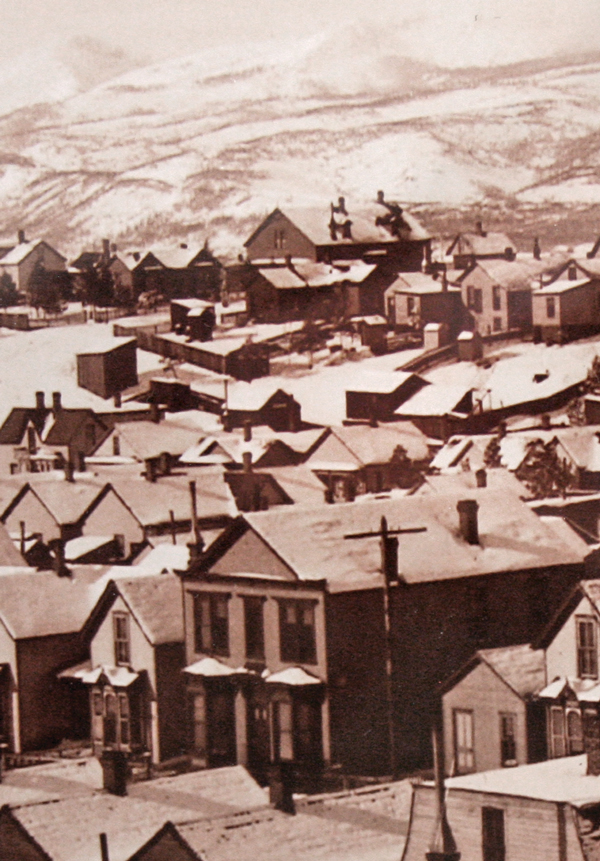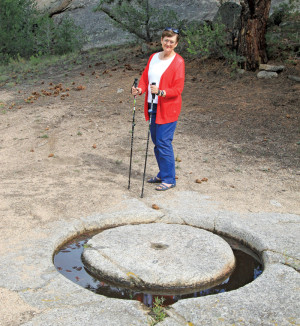By Carolyn Coleman White
For nearly 30 years, the decaying building at 134 West 6th Street in Leadville, Colorado was a party place, its windows kicked out and graffiti sprayed on the walls. Neighborhood teens used to gather there, leaving beer cans, cigarette butts and other paraphernalia scattered on the once-glossy hardwood floors. During the 1950s and 60s, before it was abandoned, it was a boarding facility, with six apartments (outlines of the numbers can still be seen on certain doors) and two shared bathrooms, one upstairs and another down. “I made a baby in the bedroom right there,” claimed a frail, stooped great-grandmother named Lydia, who now lives across the street, as she pointed toward an upper left window. “My husband had a job at the Climax mine after we moved here from New Mexico. We liked the house, but when the baby came our rented space was just too small.”

Once dangerously close to being torn down by the city, the circa 1880 Italianate home, with its bay windows, decorative brackets, narrow rooms, long center hallway (with doors at each end), and steep, 16-step staircase, was built by Mayer Guggenheim in 1880 after he’d bought an interest in a Leadville mine. A native of Switzerland, Mayer immigrated with his parents to Philadelphia, Pennsylvania in 1847 at age 19; by the time his own 11 children had been born he had long been established as a dry goods peddler, stove polish innovator, stock investor, and silver/lead tycoon. His fifth son, Benjamin – who in 1912 became famous for his chivalry on board the sinking ship, Titanic – arrived in Leadville in 1882 during his summer break from Columbia University, where he’d been studying metallurgy. He began spending part of each year in Leadville while learning the mining business, eventually becoming the bookkeeper for the Guggenheim-owned A.Y. and Minnie Mines.
Born into riches and having never seen his father’s initial struggles, Ben was accustomed to self-indulgence and was totally Edwardian in fancy clothing. He soon began frequenting the local bars, many of which were within walking distance, to drink whiskey, play cards and spend 50 cents apiece to dance with prostitutes. With his fair hair, handsome features and energetic nature, he had always been a something of a womanizer, and Leadville – far from the prying eyes of his extended family back in New York – was the perfect place to thrive and play. Even the silver crash of 1893 didn’t affect him; he traveled to Denver to work in a public assay office in order to learn more about ores, taking up residence at the Windsor Hotel … and visiting the red-light district at evening there, too.
In 1895 he wed a wealthy banker’s daughter, Florette Seligman. The marriage, which joined two family fortunes, was an unhappy one. With little regard for the three daughters which were born to them, he started traveling abroad more and more often, in part to escape the “insanity” of his wife. It has been said that Florette was both mentally deficient and neurotic, tending to repeat words several times during conversation; for example, “Benny Benny Benny, you need to call for the carriage carriage carriage.” The French singer Leontine Aubart, whom he met while in Paris, became the last of a long string of mistresses; and it was she who not only traveled with him on the Titanic but also reportedly identified herself as “Mrs. Benjamin Guggenheim” after being rescued. Not surprisingly, she disappeared almost immediately after disembarking. Ben’s brothers were quick to cover up any scandals and repeatedly discouraged his wife from filing for divorce based on how bad it would look for business. Over time Ben grew distrustful of his brothers, specifically of their plans for expansion and partnerships with outsiders. Resigning as an active partner of M. Guggenheim & Sons at the age of 36, he settled back to enjoy his take of $250,000 a year. His end, and that of the Titanic, is sadly well-known.
The elegant 6th Street house was sold in 1902 and fell into the hands of a succession of owners – getting painted red along the way – before literally being rescued by Stephen F. and Ann D. Moore in 1998. Immediately, they contacted the Harry Frank Guggenheim Foundation in New York to get a grant to help restore it. Although the front door has been replaced and the wrought iron gate was added by the next owner, for the most part the house is original. Today, the front of it looks almost identical to what it did a century ago (the large windows illustrate late 19th-century improvements in glassmaking), but restoring the interior was quite a project. “At one point, I heard it was in such a state of disrepair that the city said either tear it down or repair it,” says Mary Carey, who co-owns the place along with Front Range residents Robert and Jeanne Frick and John and Janice Garbarino. The walls, ceilings, brickwork, banister and staircase were in serious need of attention, and the entire restoration process took nearly three years. But when wandering through it now, the one fact that stands out is that Ben Guggenheim – and no doubt many members of his family and social circle – once walked the halls.

The current owners have taken great care to display reminders of Ben, as well as the Edwardian circles that he moved in, throughout the entire house. His formal portrait is on display in the living room, and the letter G graces hand towels and wine glasses. (Mary’s brother also set one in the stained glass rectangle that was made specifically to hang above the entryway.) Black and white pictures from Leadville’s history hang on the walls. Rooms have been decorated with fringed lampshades, spittoons, wind-up clocks and an astonishing assortment of turn-of-the century hats. Reproduction water basins, pitchers, rockers, bedsteads and even a fainting couch have been set up throughout. Mary, who has always enjoyed visiting Leadville from her home in Lakewood, had been renting a place down the street when the previous resident of the Guggenheim home decided to sell it and move back to Denver. She and her partners closed the sale in February 2009 and now take turns staying there. “I just love the history,” she explains. “Ben hung his coats in the closets. He walked up and down the stairs. It’s almost like he’s still here.” Instead, dressed in top hat and tails, at the age of 47, he opted to go down like a gentleman with an infamous ship. The place that he left behind in Leadville, however, remains a fine example of the era in which he once lived.
Carolyn White is a columnist, feature reporter and photographer for The Rocky Mountain Fence Post (www.thefencepost.com). She does freelance writing on the side because they don’t pay her enough.




